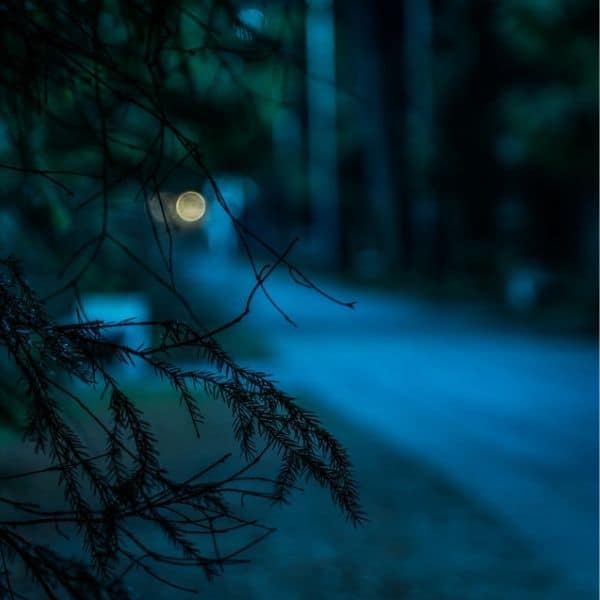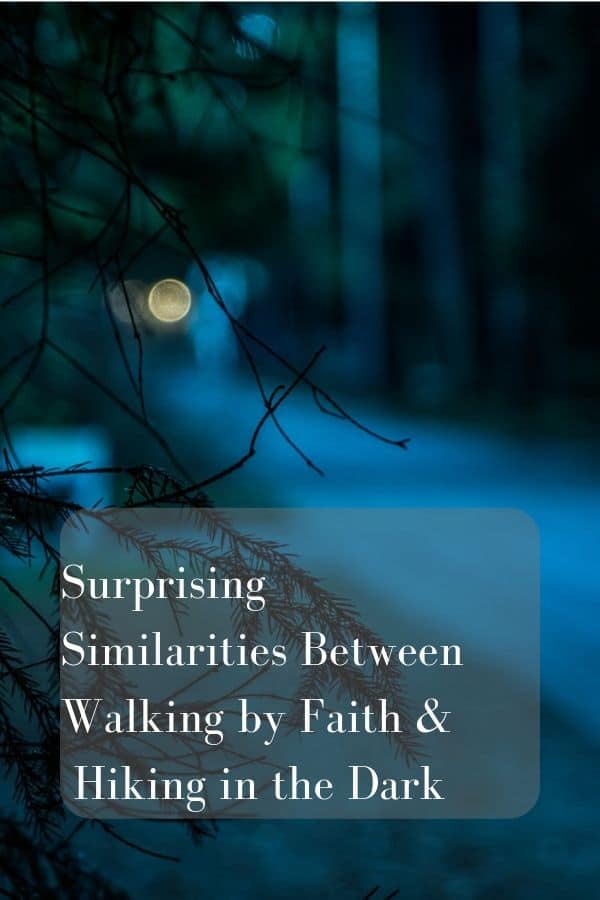
We set off, a dozen trainees, gravel crunching under our feet, toward the foreboding forest. We’d congregated at twilight to learn to hike in the dark. Like the rest of the greenhorns, I’d shown up with my flashlight because, obviously, we would need something to light the way.
What we needed, according to our trainer, was time, not a torch. He said we would have all the light we needed—from the moon. After a thirty to forty-five minute adjustment period, our night vision would kick in and we would be able to see well enough to find our way in the dark. While there was some light when we assembled, darkness settled in as we wound our way between the oak, walnut, and sycamore trees towering above the trail. With slow, careful steps we followed him down the path toward the ravines that bordered the camp. I feared the night would swallow us whole.
To hike at night is to experience the woods and the world differently. We would be free to attend to the senses that are often overshadowed by sight. Input from ears, nose, and skin becomes increasingly significant when you’re not under the influence of your eyes. When you hike at night, you become more aware of what you hear, smell, and feel.
We descended into the ravine, accompanied by a peaceful woodland soundtrack laid down by the barred owl’s haunting call and the breeze that rustled the leaves in the canopy above, panicking only occasionally at the sound of branches cracking in the forest. Slowly, incrementally, our eyes adjusted to the night and used the light of the moon to illuminate the landscape. The shape of the forest unveiled itself. Indistinct but recognizable, the woods returned to their familiar state and I found that I was content and comfortable on the trail, even in the dark.
Sometimes we walk in the dark because we want to. Sometimes we walk in the dark because we don’t have a choice. Sometimes, the landscape of a once-familiar life falls into shadow and the way forward becomes unclear.
Maybe you know what that’s like. Maybe you want to pull out a flashlight because, surely, it would be better than the available light. Maybe you want to see.
We walk by faith, not by sight. As sight-driven people, this is hard. We’re always searching for something to drive back the dark and light the way. But faith, according to Matthew Henry, “is for this world and sight is reserved for the other world.” It would be more comfortable if it was the other way around.
Faith, it seems, is not always about our comfort.
Like hiking in the dark, it is a different way to navigate. It calls us to experience the world in a way that isn’t comfortable, to be aware of our craving for light, to be attentive to that which gets overshadowed under the constant influence of sight. It’s a slower and sometimes scarier way to travel. But, it’s possible. We can navigate the landscape of life by faith without fear that that the night will swallow us whole.
As I’ve traveled some unexpected terrain in my life, I’ve noticed similarities between hiking in the dark and walking by faith. I’m sharing them today because I hope you will find something here that will encourage you as you navigate the landscape of your life.
Surprising Lessons for Walking by Faith From Hiking in the Dark
- Give it time. Just as it takes the eyes a while to adjust to the dark, adapting to new circumstances takes time. Allow yourself the time it takes, even if it’s longer than you want or expect.
- Use the available light. Even if it’s less than you want, it’s there. God rarely illuminates the way forward like a city strip lit up at night. He lights the path at our feet—enough for one step at a time.
- Don’t rush. Walking a trail—even a familiar one—is a slow process in the dark. Whether in the woods or through the terrain of your life, pay attention and move at an appropriate pace. This guards against injury and keeps you from missing out on what matters.
- Take a different perspective. Because of the nature of the eye, night vision is clearest peripherally. While we use can peripheral vision anytime, it’s not our natural inclination. We like to look at the world head-on. Faith requires us to set our focus—and our minds—a little differently, to take another perspective, to remember that the plotline of our life is part of God’s larger story—one with a victorious ending.
- Tell someone where you’re at. When you head out on the trail, it’s always a good idea to tell someone where you’re going and when you plan to return. This way, if you get into trouble on the trail, people know where and when to start looking so they can help. This is even more true when you plan to hike at night. If the landscape of your life has become unfamiliar terrain, tell someone. Two are better than one. We’re not meant to walk our life’s road alone. We’re meant to spur one another on.
And you, fellow traveler? What kind of light are you walking through as you navigate the landscape of your life? What helps you walk by faith when the road is dark?

Sharing this week with the writers at Anita’s, Lyli’s, Kelly’s, and Let’s Have Coffee!
I love this post, Natalie! Thank you for sharing your wise insight, I can definitely see the similarities. These are all great tips for our life of faith.
As someone who almost has trouble breathing when I have to walk without being able to see my feet, this really struck a chord with me, Natalie. Your five lessons are so good! One step at a time. Take it slow. And I especially love that last one … tell someone where you’re at. 🙂
It definitely applies to the life of faith, doesn’t it–especially that last one!